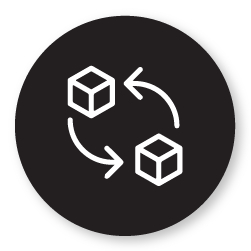It is a given that as a retailer, you would want to look for new ways to increase your sales and profits. Besides that, you need to manage your available space and find the balance between having too much or too little inventory. This is where calculating your inventory turn can help you.
How? By calculating your inventory turnover, you better understand the market demand for your products. You will also learn how much obsolete stock you may be carrying and what steps to take to either sell or stock more inventory.
About the contributors
Brian Nyamachiri joined DotActiv in 2013. An operations manager with over ten years of retail experience, he oversees Adcock Ingram, Danone, GSK, Dr Oetker, Loreal, Makro, Premier Foods, Revlon, and UPD accounts.
Kelly Cordeiro joined DotActiv in 2017. Since joining, she has had experience running many accounts, including ACDC, Ultra Liquors, Diageo, JDE Coffee, GSK, Shield, Permoseal and Pick n Pay.
Sanmari Roberts joined DotActiv in 2021 as a space planner and works on various ad-hoc accounts, including Premier Foods, Danone and Dr. Oetker. She has a BPhil (Honours) in Marketing Management from the IMM Graduate School.
Suné Oosthuizen joined DotActiv in late 2019 as a space planner. She currently works as a category planner on the Dis-Chem account in Johannesburg. She has a BConsumer Science Honours degree in Clothing Retail Management.
Yolandé Beumer joined DotActiv in May 2019 as a retail space planner for Edible Groceries at Pick n Pay before moving to Dis-Chem. In 2021, she was promoted to account manager where she will look after various ad-hoc accounts. She has a BSc in Consumer Science with Business Management from the North-West University and recently graduated with her Masters.

What is inventory turn?
Inventory turn or turnover measures the number of times inventory is sold or used in a chosen period.
It also provides you with a number that symbolises a measure of units sold compared to what is on hand. Or how well you manage your inventory and how you generate sales from what you have in stock. That is why you can view it as an indicator to understand the health of your business.
It's also one of the reasons why it is so important to understand. Other reasons include an obvious one - you don't want to hold stock that you can not sell. Especially not for so long that it becomes a problem. If you do keep stock for too long, you can expect to find yourself with obsolete inventory and a storeroom filled with stock that you can't move.
Then there is the problem of wastage, not only from spoilt stock, if it is perishable goods, but also money. Poor inventory management can lead you to tie up your capital in inventory, which can affect your cash flow. It can also affect your supply chain.
As for the positives, there are just as many. Calculating inventory turn enables you to make strategic decisions. It can help provide you with a competitive advantage. You know what sells and can look to stock more of the products your customers want. Lastly, it can help you to manage any future risks.
Need assistance managing your inventory so it works for you? Let DotActiv help
Let us explain this last point for context.
We mentioned that the inventory turn is a good indicator of the health of your business - the faster your stock turns, the healthier your business. However, it is vital to note that there is a warning here. A high inventory turn is not always good. You need to dig into and understand why it happens.
When you notice a spike in turnover, investigate it. It might mean that you're selling products that your customers want. However, it could also mean that your purchasing and replenishment strategy is not working correctly.
For example, if you experience a shortage in supply or an unexpected delay between ordering and receiving goods from your suppliers, a high turnover could put you at risk. You could run out of stock and frustrate your customers.

How do you use data to calculate inventory turn?
While you can calculate your inventory turn annually - and we recommend that - it is worth noting that you can also measure it on a monthly or quarterly basis. It depends on what you want to achieve.
When you compile your average inventory for a year, you get a clearer picture of the financial standing of your business. As for how to use your data to calculate it, there are a few ways.
It would usually use your cost of goods sold (COGS) over a year and divide that by your average inventory. Here's are the steps with the formulas for each:
Firstly, you need to determine the total cost of your goods sold. The formula here is Units Sold x Cost Per Unit. Secondly, you need to calculate the cost of your average inventory. For this step, the formula to follow is Units in Stock x Cost Per Unit.
Finally, you need to divide these two by each other: COGS ÷ Average Inventory to get your turnover rate.
This ratio is critical because your total turnover depends on two fundamental components of performance. They are stock purchasing and sales.
Looking for a category management solution? We want to help you
Let us consider stock purchasing first.
If you purchase large amounts of inventory during the year, you will need to sell more stock to improve your turnover. If you cannot achieve that, you will incur storage costs and other holding costs.
Meanwhile, your sales must match your inventory purchases, as we mentioned above. That is why the purchasing and sales departments must work together to ensure efficient inventory management and control.
Once you have the turnover rate, you can calculate how many days it takes to sell your inventory. This is your days of supply. Since there are 365 days in a year, you can divide 365 by your turnover ratio.
The result is the average number of days it takes to sell through inventory.
Here is an example to illustrate that. For this example, we'll use Rands, but you could substitute it for any currency.
You spend R137 457 (COGS) on 15 273 units of stock (average inventory) over 12 months. In this instance, your turnover rate is 9 (R137 457 ÷ 15 273). Taking this, you could divide it by your turnover rate period (365 days) to get your days of supply: 365 ÷ 9 = 40.5.
It thus takes your business a month and a half to sell all of your stock.

What can you do once you have calculated your inventory turn?
By closely monitoring your inventory, you can ensure a better handle on your inventory so you can make smarter purchasing decisions. It can also help you move more merchandise off your shelves so that you can continue making a profit.
Of course, that's not all. With this metric, you can learn which items you need to order. If the stock turn for a particular item is too high, it could indicate that you need to order more of it.
You can also learn which units you should relegate to your sales aisle. If a specific item is not selling fast enough, it may be time to put it up for sale lest it becomes dead stock.
Then there is the fact that it can show you which products you need to order in advance to allow for manufacturing, production and/or shipping time. By knowing how many times a product turns per year, you can plan to ensure you never run out or face stockouts.
That said, it’s also worth pointing out the key factors that you must look for when analysing your inventory turn.
For example, it is critical to look out for an inventory turnover ratio that is either too high or low. As mentioned earlier in this article, in many instances, a high turnover indicates your business is healthy. It shows that you're not overspending by buying too much and you're selling out appropriately.
However, when it is too high, it could indicate that you have strong sales and ineffective buying, which can lead to fluctuations in your stock holding. That's never good.
Meanwhile, a low turnover ratio indicates that there are inefficiencies that you must address. That could lead to products deteriorating in your stockroom and you struggling with holding costs. Also, you will not have any available space for the products that do sell and bring in a profit.
Conclusion
Knowing which products to stock and how much to order are game-changing insights for your retail business. Having a solid handle on your inventory turn allows you to stay on top of those decisions so you can continue carrying the products at the right time.
Do you need help managing your inventory across your business? You can book a complimentary custom exploratory consultation with us here or visit our online store.


